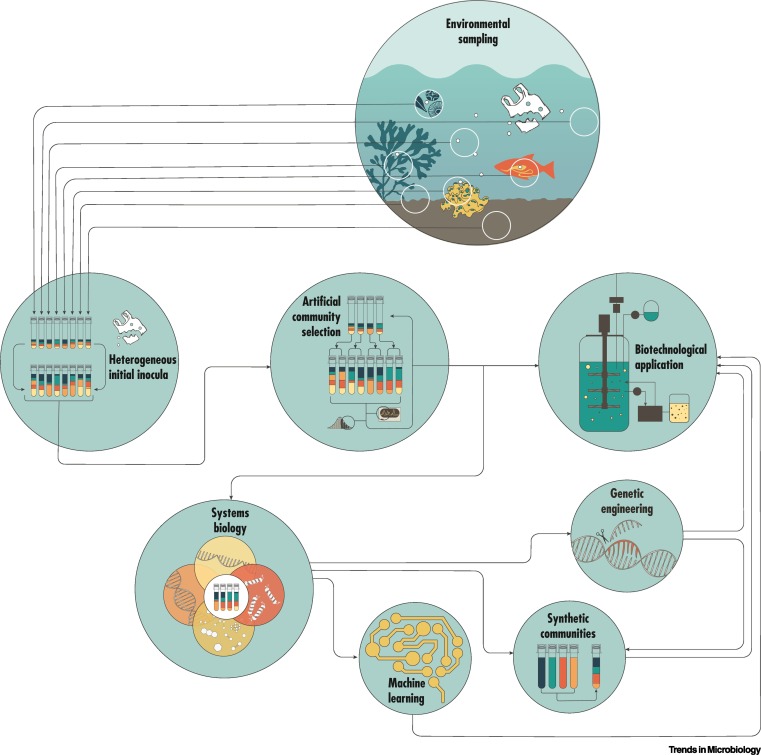
Bacteria like to settle on and in plastic bottles. This is nothing new. While these single-celled creatures that are harmful to humans can be a problem, certain bacteria can help break down plastic waste more quickly. Left to nature, this process can take centuries, depending on the object. Researchers at GEOMAR Helmholtz Center for Ocean Research and Christian Albrechts University, both in Kiel, Germany, have now presented a new approach to biodegrading plastics.
Using bacteria to keep the environment clean is nothing new, either. They have been used for decades, for example, to break down the pollutants in wastewater in sewage treatment plants into their components. In the meantime, however, the amount of plastic waste has increased more and more, and bacteria that can break down plastics are still hardly known. In the international journal Trends in Microbiology, Kiel researchers are now proposing a method for faster and more effective natural degradation of plastics, something that has been neglected until now. “We suggest that it would make much more sense to test entire bacterial communities for their capabilities instead of looking for individual bacterial species that produce enzymes with which they can break down plastics,” says Dr. Peter Deines of GEOMAR, lead author of the study.
Unexplored bacterial communities
Until now, researchers have focused on finding individual species of bacteria in this context. Once a species has been found that might be able to break down a type of plastic with a special enzyme, the genetic information of the bacterium is searched for the code for this enzyme. “But there is the danger in doing this that you will only find information that is already known and overlook other important capabilities,” says Dr. Deines.
Besides, concentrating on a single bacterial species carries a risk for later applications of the bacterium and its enzyme, such as in bioreactors, he adds. “We know from ecosystem biology that monocultures are not very resilient. In fact, bioreactors with only one bacterial species have a high failure rate,” reports the Kiel microbiologist.
That’s why Deines and his colleagues work with entire bacterial ecosystems. The places where bacteria are most likely to come into contact with plastic could be the stomachs of fish, biofilms on large algae, or the sediment of the sea floor. These previously unexplored bacterial communities are then introduced to more plastic in the lab. If the bacterial community can degrade the plastic, it will be selected for the next step.
Marine bacterial communities
“We propose growing entire bacterial communities in the lab for increased plastic degradation,” Deines emphasizes. This process, he says, can be thought of in much the same way as selecting for specific traits in breeding pets or plants. “With this method, we don’t have to know in advance what we’re looking for; we’re completely open-ended. The risk of overlooking abilities is much lower. After all, a bacterium that can’t do anything with plastic on its own may still make a decisive contribution to its degradation in a complex community,” he explains. Subsequent artificial selection in the lab would give microbial communities the chance to improve their plastic degradation abilities over the course of several generations. “So here we are using an approach from evolutionary biology.”
Next, the researchers plan to put these new methods into practice, focusing primarily on marine bacterial communities. “Ultimately, the ocean is a big sink where most waste and pollutants end up. As part of the PLASTISEA project, we have already obtained many samples from the central Atlantic,” says co-author Prof. Hentschel Humeida, head of the Marine Symbioses research unit at GEOMAR. “We are now using these to look for ways to biodegrade plastic both in the classical way and with this new method. But, of course, this can also be used to look for degradation opportunities for many other pollutants.”
Cover photo: A concept for using artificial community selection for microbial degradation of pollutants. © Graphic from Borchert, Hammerschmidt, Hentschel, Deines (2021), Trends in Microbiology.
Also of interest:
Division of tasks among different types of bacteria in breaking down plastic
New enzyme cocktail breaks down plastic waste six times faster
Going after Plastic Garbage with “Molecular Scissors”

